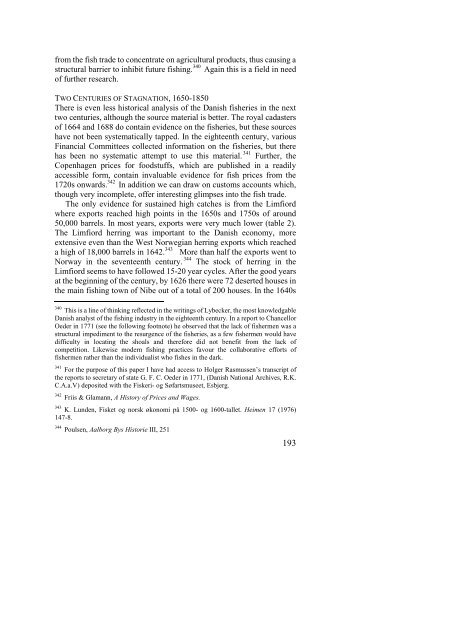The North Atlantic Fisheries, 1100-1976 - University of Hull
The North Atlantic Fisheries, 1100-1976 - University of Hull
The North Atlantic Fisheries, 1100-1976 - University of Hull
You also want an ePaper? Increase the reach of your titles
YUMPU automatically turns print PDFs into web optimized ePapers that Google loves.
from the fish trade to concentrate on agricultural products, thus causing a<br />
structural barrier to inhibit future fishing. 340 Again this is a field in need<br />
<strong>of</strong> further research.<br />
TWO CENTURIES OF STAGNATION, 1650-1850<br />
<strong>The</strong>re is even less historical analysis <strong>of</strong> the Danish fisheries in the next<br />
two centuries, although the source material is better. <strong>The</strong> royal cadasters<br />
<strong>of</strong> 1664 and 1688 do contain evidence on the fisheries, but these sources<br />
have not been systematically tapped. In the eighteenth century, various<br />
Financial Committees collected information on the fisheries, but there<br />
has been no systematic attempt to use this material. 341 Further, the<br />
Copenhagen prices for foodstuffs, which are published in a readily<br />
accessible form, contain invaluable evidence for fish prices from the<br />
1720s onwards. 342 In addition we can draw on customs accounts which,<br />
though very incomplete, <strong>of</strong>fer interesting glimpses into the fish trade.<br />
<strong>The</strong> only evidence for sustained high catches is from the Limfiord<br />
where exports reached high points in the 1650s and 1750s <strong>of</strong> around<br />
50,000 barrels. In most years, exports were very much lower (table 2).<br />
<strong>The</strong> Limfiord herring was important to the Danish economy, more<br />
extensive even than the West Norwegian herring exports which reached<br />
a high <strong>of</strong> 18,000 barrels in 1642. 343 More than half the exports went to<br />
Norway in the seventeenth century. 344 <strong>The</strong> stock <strong>of</strong> herring in the<br />
Limfiord seems to have followed 15-20 year cycles. After the good years<br />
at the beginning <strong>of</strong> the century, by 1626 there were 72 deserted houses in<br />
the main fishing town <strong>of</strong> Nibe out <strong>of</strong> a total <strong>of</strong> 200 houses. In the 1640s<br />
340 This is a line <strong>of</strong> thinking reflected in the writings <strong>of</strong> Lybecker, the most knowledgable<br />
Danish analyst <strong>of</strong> the fishing industry in the eighteenth century. In a report to Chancellor<br />
Oeder in 1771 (see the following footnote) he observed that the lack <strong>of</strong> fishermen was a<br />
structural impediment to the resurgence <strong>of</strong> the fisheries, as a few fishermen would have<br />
difficulty in locating the shoals and therefore did not benefit from the lack <strong>of</strong><br />
competition. Likewise modern fishing practices favour the collaborative efforts <strong>of</strong><br />
fishermen rather than the individualist who fishes in the dark.<br />
341 For the purpose <strong>of</strong> this paper I have had access to Holger Rasmussen’s transcript <strong>of</strong><br />
the reports to secretary <strong>of</strong> state G. F. C. Oeder in 1771, (Danish National Archives, R.K.<br />
C.A.a.V) deposited with the Fiskeri- og Søfartsmuseet, Esbjerg.<br />
342 Friis & Glamann, A History <strong>of</strong> Prices and Wages.<br />
343 K. Lunden, Fisket og norsk økonomi på 1500- og 1600-tallet. Heimen 17 (<strong>1976</strong>)<br />
147-8.<br />
344 Poulsen, Aalborg Bys Historie III, 251<br />
193















